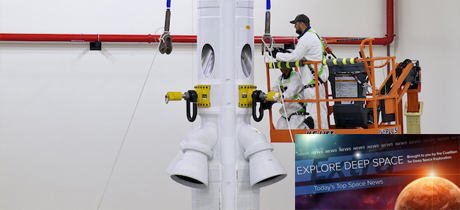Please note that CDSExtra will be on hiatus for the 4th of July holiday and also on Friday, July 5. We will return on Monday, July 8.
In Today’s Deep Space Extra… NASA’s Orion program and its contractor team cheered the success Tuesday of the Ascent Abort Test-2 launch and three minute flight from Cape Canaveral Air Force Station, Florida. The test demonstrated a critical technology developed to protect the lives of NASA astronauts assigned to the Moon and other deep space destinations.
Human Space Exploration
NASA successfully tests Orion launch abort system before Moon flights
Coalition Members in the News – Aerojet Rocketdyne, Lockheed Martin, Northrop Grumman
Spaceflightnow.com (7/2): NASA declared the final planned test flight of the Space Launch System (SLS)/Orion Launch Abort System from Cape Canaveral Air Force Station, Florida early Tuesday a success. Launched for the test atop a U.S. Peacekeeper mission first stage, the rocket rose to about six miles altitude when the abort motor fired with 400,000 pounds of thrust to lift the uncrewed Orion crew capsule safely away. The Launch Abort System is to be mated to an Orion/Space Launch System (SLS) stack with a small crew of astronauts on a test flight around the Moon called Artemis 2, planned for late 2022 or 2023. Video: https://www.youtube.com/watch?v=4rfsDMGplZU
After own failed rocket launch, astronaut gives Orion safety test thumbs up
Space.com (7/2): Among those praising the success of the NASA’s Ascent Abort Test-2 on Tuesday was U.S. astronaut Nick Hague. Hague and cosmonaut Alexey Ovchinin were forced to abort their Russian Soyuz MS-10 launch on October 11, 2018 when their launch vehicle failed to stage properly with its International Space Station (ISS) bound crew after lifting off from the Baikonur Cosmodrome in Kazakhstan. Both men survived as their capsule separated and descended back to Earth under parachute. “As someone who has had his life saved by a launch abort system, I can attest that today was a truly significant milestone…,” Hague commented on Twitter. Hague and Ovchinin launched to the ISS in March.
Photos: NASA launches Orion capsule from Cape Canaveral Air Force Station
Florida Today (7/2): The test flight of NASA Orion’s Launch Abort System rose into blue skies from Cape Canaveral Air Force Station, Florida, on Tuesday at 7 a.m., EDT.
Space Science
European Mars lander suffers parachute damage in test
SpaceNews.com (7/2): ExoMars managers hope to overcome a parachute test failure as part of preparations for a European Space Agency (ESA)/Russian collaboration on ExoMars, a Mars lander/rover mission planned for launching in July 2020 to look for evidence of past and possibly current microbial activity on the red planet.
Atmosphere of midsize planet revealed by Hubble, Spitzer
NASA/Jet Propulsion Laboratory (7/2): Planets between the sizes of the Earth and Neptune are among the most common planets in the Milky Way Galaxy, though not present in our solar system, according to surveys by NASA’s Kepler space telescope. Now, astronomers have used the Hubble and Spitzer space telescopes to study a prime example in the category, Gliese 3470b, about 100 light years away. Their observations are laying the ground work for a more detailed study by the James Webb Space Telescope (JWST), which is being prepared for a March 2021 launch.
First contact! LightSail 2 phones home to Mission Control
Planetary Society (7/2): Launched June 25 aboard a SpaceX Falcon Heavy rocket as part of a large and diverse U.S. Air Force Space Test Program-2 mission, the Planetary Society’s LightSail 2 experimental satellite was deployed from its Prox-1 carrier on Tuesday. The privately funded LightSail CubeSat will be checked out in the coming days before a decision is made to proceed with deployment of the Mylar light sail. About the size of a boxing ring, the light sail is designed to use the forces from solar photon impacts to raise its orbital altitude to demonstrate a potential future space propulsion technology.
Who wants to be a trillionaire? Mission to Psyche could uncover tons of precious metals!
Universe Today (7/2): NASA’s planned 2022 planetary science mission to the asteroid Psyche could have a striking economic impact. The main belt asteroid may in fact be the metallic core of a former planet. At 140 miles in diameter, Psyche is comprised of valuable gold and platinum as well as nickel and iron. The mission could open the door to asteroid mining, according to some visionaries.
Other News
Pentagon eyes military space station
Breaking Defense (7/2): The Pentagon’s Defense Innovation Unit is eyeing an orbital platform to support space experiments and operations and not ruling out that it could be staffed.
Solar eclipse shrouds parts of South America in temporary darkness (photos)
National Public Radio (7/2) Chile and Argentina were the places to be on Tuesday to view a total solar eclipse. Another in the U.S. is not expected until April 8, 2024.
Apollo 11
Apollo 11’s Michael Collins reflects on historic Moon landing: ‘We were just regular astronauts’
Fox News (7/2): Apollo 11’s Command Module pilot Michael Collins explains his role on the first ever mission by human explorers to touchdown and walk on another planetary body. Collins orbited the Moon in the Apollo 11 Columbia command module, while the better known Neil Armstrong and Buzz Aldrin made their way to the Moon’s Sea of Tranquility and back in the Eagle lander. Collins applauds their selection to make the historic descent to the lunar surface.
Moon landing at 50: Apollo astronauts reflect on JFK’s challenge and the future of space travel
Newsweek (7/2) Eight of NASA’s Apollo era astronauts reflect on the nation’s efforts to reach the surface of the Moon from Apollo 7 through Apollo 17.

